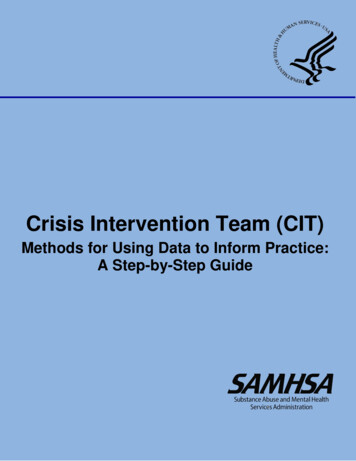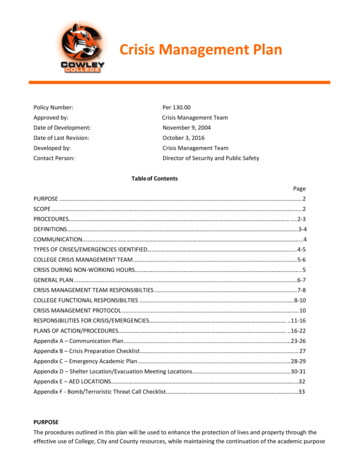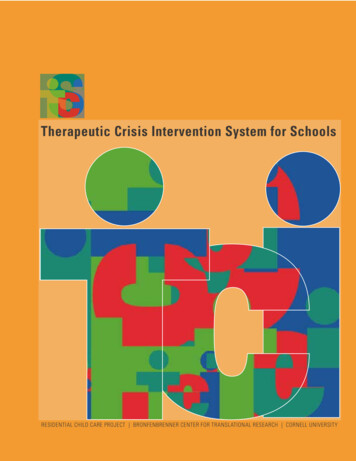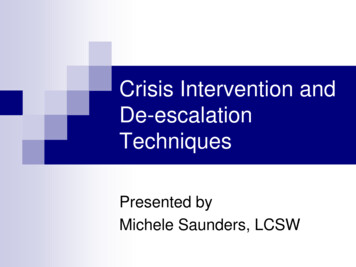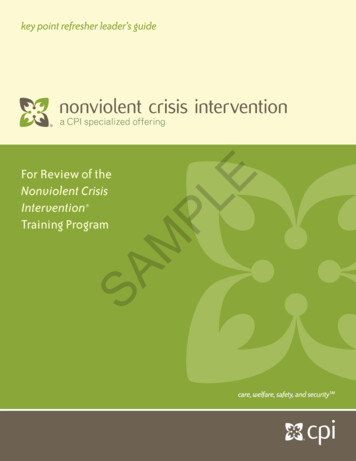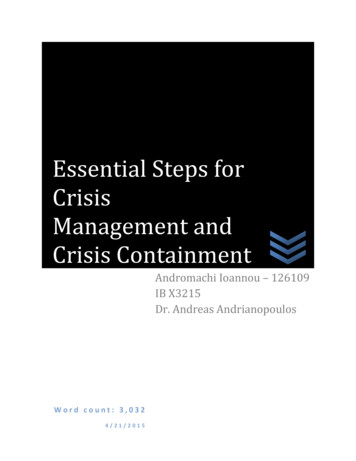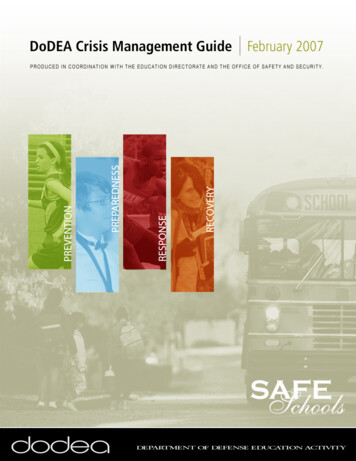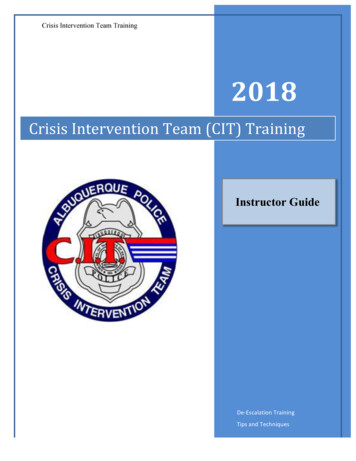
Transcription
Crisis Intervention Team Training2018Crisis Intervention Team (CIT) TrainingInstructor GuideDe-Escalation TrainingTips and Techniques
COURSE TITLE PAGEProgram:Crisis Intervention Team (CIT) TrainingBlock:De-escalation TrainingCourse#/Title:Tips and TechniquesAccreditation#:NM170753Course Level:Advanced TrainingPrerequisites:NoneInstructional Method:Lecture, Power Point, Exercises, DiscussionTime Allotted:1 HourTarget Group:New Mexico Law Enforcement Basic and CertifiedOfficers; Basic and Certified TelecommunicatorsInstructor/Student Ratio:1/35Evaluation Strategy:Pre-Test/Post-Test, Class discussionRequired InstructorMaterials:Lesson Plan, Power Point, Video, Handouts,DiscussionRequired StudentMaterials:Note-taking materials, Student ManualSuggested InstructorCertification:General InstructorSpecialized InstructorCIT InstructorProfessional LecturerMaster InstructorNoesner, G., & Webster, M. (1997). Crisis Intervention:Using Active Listening Skills in Negotiations. LawEnforcement Bulletin. FBI.Rogers, C., & Dymond, R. (1954). Psychotherapy andPersonality Change. Chicago: University of ChicagoPress.SourceDocument/Bibliography:Price, O., & Baker, J. (2012). Key components of deescalation techniques: A thematic synthesis.International Journal of Mental Health Nursing, 310319.Bowers, L. (2014). A model of de-escalation.International Journal of Law and Psychiatry.Livingston, J., Desmarais, S., Verdun-Jones, S.,Parent, R., Michalak, E., & Brink, J. (2014).Perceptions and experiences of people with mental
illness regarding their interactions with police.International Journal of Law and Psychiatry, 334-340.Black, M.J. and Yacoob, Y. (1995). Recognizing facialexpressions under rigid and non-rigid facial motions.Proceedings of the IEEE International Workshop onAutomatic Face and Gesture Recognition ‘95, pp. 1217.Thompson, G. (1983). Verbal judo: Words as a forceoption. Springfield, Ill.: Charles C. Thomas.Thompson, G. (1994). Verbal judo: Redirectingbehavior with words. Jacksonville, Fla.: Institute ofPolice Technology and Management.Thompson, G., & Jenkins, J. (2004). Verbal judo: Thegentle art of persuasion. (Rev. ed.). New York: Quill.Ekman, P. (1992a). Are There BasicEmotions?. Psychological Review, 99(3), 550-553.Lazarus, R. S. (1991). Emotion and Adaptation. NewYork: Oxford University Press.Davidson, J. A. and Versluys, M. 1999. Effects of brieftraining in cooperation and problem solving on successin conflict resolution. Peace and Conflict: Journal ofPeace Psychology, 2: 137–148.Rütgen, M., Seidel, E., Silani, G., Riečanský, I.,Hummer, A., Windischberger, C., . . . Lamm, C. (2015).Placebo analgesia and its opioidergic regulationsuggest that empathy for pain is grounded in selfpain. Proceedings of the National Academy ofSciences Proc Natl Acad Sci USA, 112(41).Vecchi, G. M., Hasselt, V. B., & Romano, S. J. (2005).Crisis (hostage) negotiation: Current strategies andissues in high-risk conflict resolution. Aggression andViolent Behavior, 10(5), 533-551.Diagnostic and statistical manual of mental disorders:DSM-V-TR. (2013). American Psychiatric Association.City of Albuquerque, Police Department. (n.d.). 2-19Response to Behavioral Health Issues.City of Albuquerque, Police Department. (n.d.). 2-20Hostage, Suicidal/Barricaded Subject, and TacticalThreat Assessment.
City of Albuquerque, Police Department. (n.d.). 2-82Restraint and transportation of prisoners.City of Albuquerque, Police Department. (n.d.). 2-52Use of ForceCity of Albuquerque, Police Department, CIT Course,Active Listening Skills.
COURSE GOAL:To prepare the student to handle situations involving people with mental illness and in crisis with deescalation skills to reduce unnecessary force and develop rapport.LEARNING OBJECTIVE(S):Upon completion of training, the participant will be able to demonstrate the following measurablelearning objectives:1. Describe commonly used de-escalation techniques.2. Apply de-escalation techniques.3. Demonstrate de-escalation techniques.
Welcome (Slide 1) Welcome students and introduce yourself. You may want to include your name on thisPowerPoint or write it on a whiteboard or flip chart.Provide a brief overview of the class and what to expect.Ask for cell phones and computers to be turned off.Definition (Slide 2)De-Escalation Techniques A variety of psychosocial techniques aimed atreducing violent and/or disruptive behavior. Skills used to reduce/eliminate the risk of violenceduring an escalation phase through verbal and nonverbal communications. Less authoritative, less controlling, lessconfrontational approach to gain more control.Crisis Intervention Training2 De-escalation techniques consist of a variety of psychosocial techniques aimed at reducingviolent and/or disruptive behavior. Review Slide Video Discussion- Law Enforcement Crisis Intervention De-escalationReview videoActive ListeningApproachOfficer’s hands and body posture
What happens in a crisis? (Slide 3) Review SlideDiscussion- What Happens in a Crisis?Ask students what they have seen in someone experiencing a crisis. Fight, Flight, or Freeze Deer in headlights Difficulty with decision makingDe-escalation (Slide 4) Review the points on slide.Speak on the importance of self-control and being prepared for work.The 7 Active Listening Skills are covered in previous course.What is the goal of the interaction what should be resolved.*See next page.
Discussion – Respect vs DignityAsk for students to define the difference.Merriam-Webster Definitions:Respect A feeling of admiring someone or something that is good, valuable, important,etc. A feeling or understanding that someone or something is important, serious,etc., and shouldbe treated in an appropriate way A particular way of thinking about or looking at somethingDignity A way of appearing or behaving that suggests seriousness and self-controlThe quality of being worthy of honor or respectVideo Discussion (Slide 5)Video DiscussionCrisis Intervention Training 5Show the following videos before discussiono Anderson Silva Breaks Lego Drunk Guy Falls Down HillDiscussion- Bias and Pain Receptiono Ask students to share bias they may have.o Law Enforcement connects with fighters, belief that we are warriors.o We associate alcohol with negative encounters.o When we watch people get hurt we can feel pain empathy.*See next page.
Show any of the videos titled “judge ” (4 different one)o Talk about how this is common in law enforcement and we must be aware at times ofhow our body positioning and approach may be viewed from an outside perspective. Show any of the Lie Witness News videoso Why do people believe the fake reporter?o People have trust in what they believe is right.o Law Enforcement is a trusted profession so we must be careful with misleading people.Models: C.A.F. (Slide 6) Calm, Assess, and Facilitate- This is overall goals of interactionsCreated by the University of FloridaFirst calm the situation. Reduce lights, noises, personnel, and others obstacles.Assess the individual for their needs.Is this a medical emergency or is this a criminal investigation?Facilitate the appropriate resources.o Ambulanceo Mental health providero Jail (if incident is criminal nt.cfm?item 136#trainingresources
Models: L.E.A.P.S. (Slide 7) This model is by Dr. George Thompson in Verbal Judo (http://verbaljudo.com).This is a model on communication.Has been adopted by many law enforcement training programs.Listening means you listen, officers have the tendency to interrupt communication with factfinding line of questioning.Empathy has been discussed. This would be good time to use a student previously mentioneddefinition.Get as much information as you can use open ended questions.Models: ALGEE (Slide 8)ModelsALGEE Assess for risk of suicide or harm Listen nonjudgmental Give reassurance and information Encourage appropriate professional help Encourage self-help and other support strategiesCrisis Intervention Training 8This is the Mental Health First Aid Model (http://www.mentalhealthfirstaid.org)Created in Australia and adopted by the National Council for Behavioral Health in the U.S.This is geared toward basic initial assessments but can be utilized to help with decisionmaking.
Models: E.A.R. (Slide 9)ModelsE.A.R. Engage: build trust by validating the person andtheir situations Assess: gather necessary information to make asafe resolution Resolve: gain control of the situation and return tothe pre-crisis stateCrisis Intervention Training 9This was introduced during House Bill 93 training.These are the stages of a crisis encounter.Student may remember a video of Paul Lilley (Ohio) speaking of this from in-service training.Common Themes (Slide 10)Common Themes Listening Respect Dignity Rapport BuildingCrisis Intervention Training Review slide.Ask students if they see other themes evolving.o Customer service oriented.o Empathetic approach.10
Summary (Slide 11)Summary Establish rapport to gain trust Minimize restrictions Protect self-esteem (Respect & Dignity) Calm appearance Self-aware Be flexible with interventions to reduce theneed for aggression11Crisis Intervention Training Review the slide.Summarize any in class discussion to help drive home learning points.Thanks (Slide 13) EndingThanks Questions, Comments, Etc Insert name and organizationCrisis Intervention Training Please insert your (instructor) name and contact information.12
Acknowledgements:This course was created with collaborations from the following people and organizations:Albuquerque Police Department:Matthew TinneyNils Rosenbaum, MDMental Health Response Advisory CommitteeUniversity of New Mexico Clinical Education:Mary Magnusson, MSN, RN
De-Escalation Techniques A variety of psychosocial techniques aimed at reducing violent and/or disruptive behavior. Skills used to reduce/eliminate the risk of violence during an escalation phase through verbal and non-verbal communications. Less authoritative, less control
